|
|
|
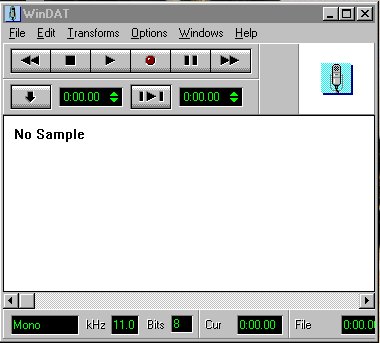
Commands
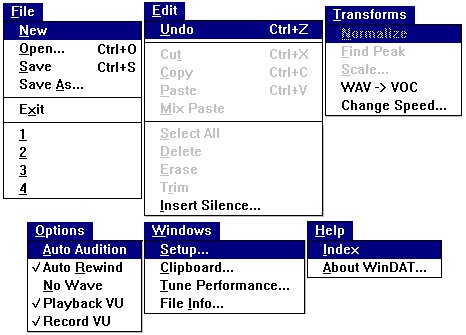
File
New
Creates a new, empty file based on the settings in the Setup window. New does not erase the contents of the Clipboard.
Open
Presents a dialog box to select a file to load. The Files dialog box also lets the user select the file type to open (.WAV or .VOC).
Save
Saves the currently loaded file to disk. If the file already has a name, it will be saved with that name. Otherwise, the Save As... dialog box will appear.
Save As
Presents a dialog box for naming and saving the current file to disk.
Exit
Quits WinDAT.
File List
The bottom portion of WinDAT's File menu lists the last four audio files that have been opened or saved, with the most recently-opened file listed at position
This makes it easy to re-open any of the last four files worked on. To open an audio file in the Files List, simply click on the desired file name.
Edit
Undo
Restores the file to the state it was in before the last Edit or Transform operation.
Cut
Removes the selected range and shifts the rest of the file back to fill in the gap, similar to deleting text in a word processor. The deleted data is placed in WinDAT's Clipboard.
Copy
Puts a copy of the selected range in the Clipboard without altering the file.
Paste
Inserts the contents of the Clipboard at the start of the currently-selected range (as indicated by the Start Marker), and shifts the data after that point to the
right.
Mix
Paste
Mixes the contents of the Clipboard with the data in the current file, beginning at the Start point of the currently-selected range (as indicated by the Start Marker).
Select All
Selects the entire length of the file as the range. This is useful for executing an Edit or Transform on the entire file.
Delete
Deletes the selected range, but does not move the data to the Clipboard.
Erase
Puts a copy of the selected range in the Clipboard and replaces it with silence.
Trim
Deletes all data except the selected range. The contents of the Clipboard remain unchanged. Trim is useful for eliminating unwanted data at the beginning and end of a recently recorded file.
Insert
Silence
Inserts a specified amount of silence at the Start Marker, shifting everything after the Start Marker to the right.
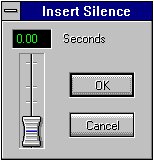
Transform
Normalize
Scales the amplitudes in the selected range so that the peak value is converted to the maximum possible amplitude; the rest of the amplitudes are scaled proportionally. The "Normalize" selection lets the user optimize the loudness of files that have been recorded at too low a level, without introducing distortion.
Find Peak
The "Find Peak" Transform locates the highest level (amplitude) within the selected range, and then displays a dialog box with information about the peak. "Find Peak" gives the user a convenient way to locate unwanted peaks that may be causing distortion so that they can be Scaled, Deleted, etc.
Scale
The "Scale Transform" is used to increase or decrease the loudness (amplitude) of the selected range by a specified factor between .01 and 10.00. For example, a scaling factor of willl double the amplitude, and a factor of 0.5 will halve the amplitude. Scale is useful for matching the loudness between different files when cutting and pasting between them.
WAV-VOC
Converts the current file from the Microsoft .WAV format to the Creative Labs .VOC format.
Change Speed
Allows the user to change the apparent speed of the current file by converting the
sample rate. Higher sample rates will make the file playback faster and at a higher pitch, and lower sample rates will produce slower
and lower pitched playback.
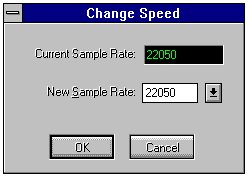
Options
Auto Audition
The "Auto Audition" option lets the user automatically preview audio files: simply click on the audio files from the Files list box. Enable "Auto Audition" in the Options menu, then choose Open or Save As from the Files
menu. When clicking on a file in the Files list box, WinDAT will play that file until the user clicks on another file or control.
Auto Rewind
When the "Auto Rewind" option is enabled, WinDAT will automatically rewind to the beginning of the file after it stops playing.
No Wave
When the "No Wave" option is enabled, the Graphic File Display will disappear and WinDAT's entire window will shrink vertically. The "No Wave" option will reduce WinDAT's size so that it can share the desktop with other applications. Additionally, it can help save time by eliminating the wait normally required for re-drawing the graphic file display (especially when working with large files), and it can help reduce the amount of system overhead when playing back files at high data rates. When clicking on "No Wave" again to disable it, the Graphic File Display will return and WinDAT will be restored to its previous window height.
Playback VU
When the "Playback VU" option is enabled, WinDAT's VU Meters will be active during playback. Disabling the VU meters can help to reduce system overhead if the user is experiencing difficulty playing files back at high data rates.
Record VU
When the "Record VU" option is enabled, WinDAT's VU Meters will be active during recording. Disabling the VU meters can help to reduce system overhead if the user is experiencing difficulty recording at high data rates.
Always On Top
When the Always on Top option is enabled, WinDAT will always appear on
top of any other applications that are running. This prevents WinDAT from getting "lost" when running several different programs.
Window
Setup
Displays the Setup dialog box for selecting the File Format (VOC or WAV), Sample Rate, Stereo/Mono, Bit Length/Data Format,Temp Directory and Work Directory . When
a file is loaded, the Setup dialog box will always display the sample rate that the file was saved with. When choosing OK from the Setup window, its settings are saved as WinDAT's new defaults.

Clipboard Window
Activates a window containing information about the contents of WinDAT's Clipboard, such as what file the data came from, the duration of the data, etc. Clicking on the Clipboard window's "Play" button lets the user audition the contents of the Clipboard before performing a "Paste"
or "MixPaste" operation.
Note
WinDAT uses its own Clipboard format, which allows it to share data with OLE Client applications and other Voyetra programs, such as AudioView, Annotator, etc.
It is not to be confused with the regular "Windows Clipboard".
Performance Tune
The "Performance Tune" window lets the user adjust various WinDAT parameters to eliminate difficulties playing or recording at high data rates. In general, the user should only modify the default Performance Tune settings if experiencing data rate difficulties. Such difficulties are indicated either by a file that cuts-off abruptly, or by a "Disk Could Not Keep Up With Digital Audio" error message.
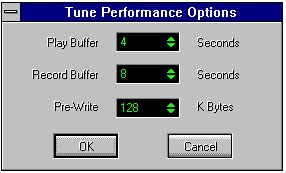
Play Buffer
(Default=4 Seconds) Determines the size of the memory buffer that WinDAT will use during playback.
Record Buffer
(Default=8 Seconds) Determines the size of the memory buffer that WinDAT will use during recording.
Pre-Write
(Default=128Bytes) When preparing to record, the Pre-Write setting will determine the size of the area on the hard drive that WinDAT will "pre-allocate" for the digital audio data (in kBytes). This gives WinDAT access to a contiguous area of the disk, minimizing the overhead required to record the data.
Note
If encountering difficulties during playback of a high data rate file (i.e. 44k, 16 bit, stereo), try to increase the value of the Play Buffer. If encountering difficulties while recording, try to increase the value of the Record Buffer. Or increase the size of the Pre-Write value. It should be equal to the maximum size of the file being recorded (in Kilobytes).
File Info
Provides statistical information for the currently loaded file including; sample rate, bit resolution, length, size, format, etc.
Help Index
Activates WinDAT's on-line Help system.
About Windat
Displays information about WinDAT's date and revision.